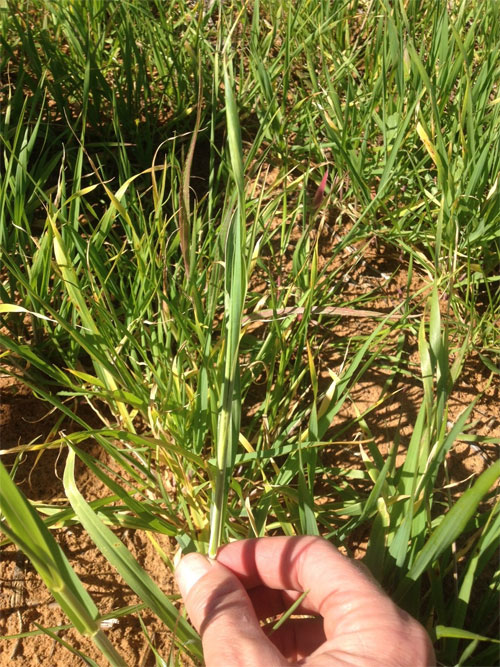Australia
August 26, 2016

Recent damage caused by Russian wheat aphid. Photo: Craig Davis
As cereal crops reach critical growth stages and with the onset of warmer temperatures, grain growers in South Australia and Victoria are advised to be even more vigilant and inspect crops regularly for Russian wheat aphid (RWA).
First detected in Australia on a property in SA’s Mid North in May this year, RWA is now relatively widespread across Victorian and SA cereal-growing areas and has recently been detected in New South Wales. With some exceptions, cold and wet conditions over winter have generally curtailed activity and damage to date.
However, milder weather conditions in some areas over recent weeks has stimulated increased aphid activity and changes in pest development. In particular, warmer temperatures have triggered development of wing buds on some aphids and resulted in subsequent localised movement.
Yield loss in cereals is proportionate to RWA numbers, number of tillers infested and crop growth stage, with the greatest potential for direct feeding-related yield losses likely from early booting through until the soft dough stage. It is particularly critical to avoid damage to the major yield-contributing leaves (flag, Leaf 2 and Leaf 3), but growers should seek expert advice before spraying based upon careful consideration of aphid numbers.
Latest advice from the SA Research and Development Institute (SARDI*) suggests that, at tillering and beyond, spraying is warranted only where RWA is detected on at least 10 percent of tillers, from a minimum of 50 tillers sampled across a paddock.
SA agronomist Craig Davis says a “wait and see” approach is currently the most appropriate strategy.
“I’m encouraging growers to refrain from blanket applications of pesticides until they have a problem – they should hold off until those thresholds have been reached,” Mr Davis says.
“We need to allow an opportunity for populations of beneficial insects to build up and provide natural control. If we knock out the beneficials through unnecessary spraying we are setting ourselves up for issues in terms of integrated management options.”
Dr Michael Nash from SARDI says rising temperatures will favour population build-up and dispersal, and that physical inspection of crops is required to accurately assess population levels.
“This means inspecting each randomly collected tiller closely, as aphid presence is not always obvious and can be easily overlooked,” Dr Nash said.
If growers encounter infestations that warrant spraying, chlorpyrifos or pirimicarb may be used for control under Emergency Use Permit APVMA 82792. Growers are urged to consider use of pirimicarb as a softer option to avoid detrimental effects to beneficial insect populations.
With improving weather conditions, beneficial populations are expected to increase and provide an important biological control mechanism in crops over spring.
The Grains Research and Development Corporation (GRDC), which is investing in ongoing research efforts to fill the gaps in current understanding of RWA biology, population dynamics and specific control options, is continuing to encourage southern region grain growers to adopt a simple four-point plan in dealing with the pest.
The “FITE” strategy revolves around four basic principles:
- Find (look for characteristic leaf streaking or rolling symptoms on cereal crops and grasses)
- Identify (positively identify RWA in consultation with an industry specialist)
- Threshold approach (consider international thresholds for control, factoring crop growth stage, yield potential and potential yield losses)
- Enact an appropriate management strategy that where possible encourages beneficial insects and protects honeybees.
The GRDC has produced an extensive Paddock Practices resource on RWA to inform grain growers’ management strategies. It is available on the GRDC website at https://grdc.com.au/Media-Centre/GRDC-E-Newsletters/Paddock-Practices/Monitor-RWA-numbers-closely-over-winter.
To view a GRDC GroundCover TV video on RWA, go to https://grdc.com.au/video-russianwheataphid.
The GRDC’s popular Crop Aphids Back Pocket Guide now includes information on RWA. It can be downloaded via https://grdc.com.au/CropAphidsBackPocketGuide,
* SARDI is a division of Primary Industries and Regions SA (PIRSA).